Menu
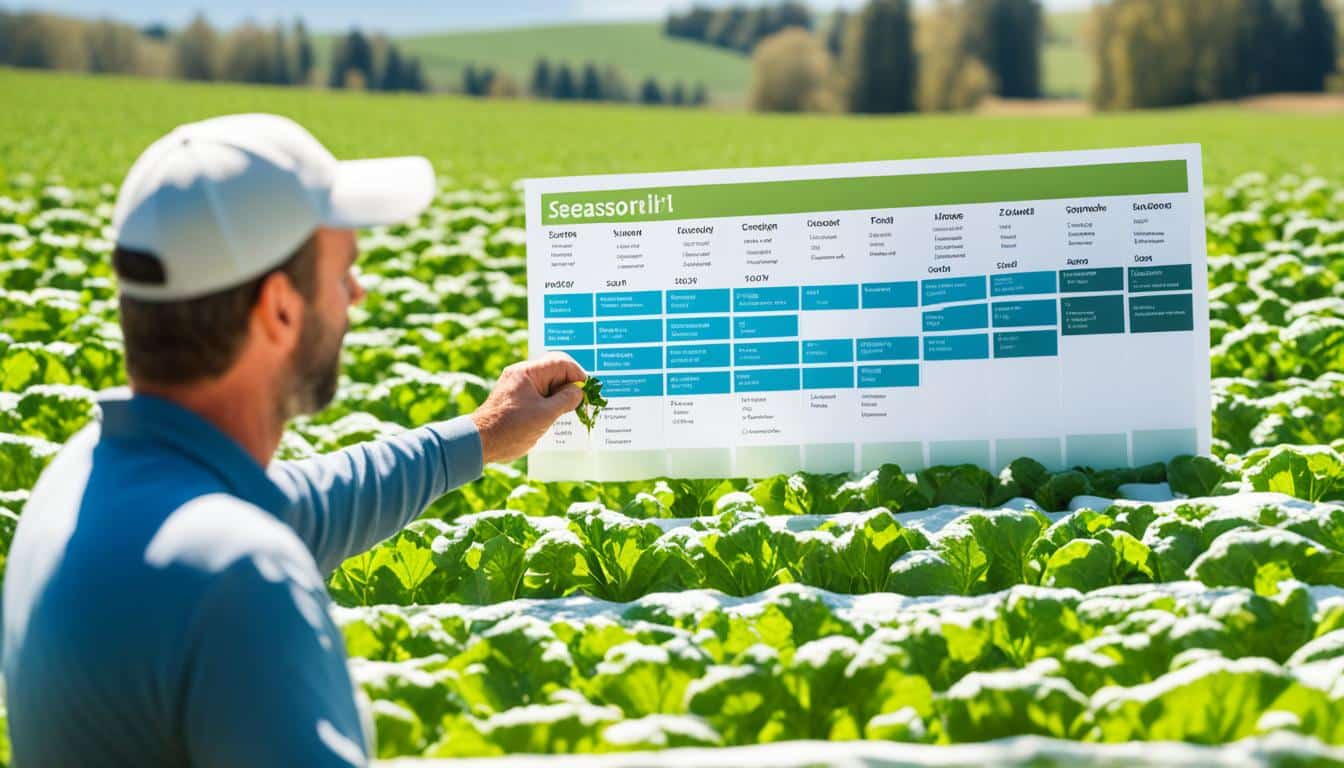
Did you know nearly 60% of farming success relies on getting ready for each season? For farmers, spring is a critical time; it begins around March 20th. Knowing the specific challenges of your area is essential—snow melt can lead to floods in the north, while the south may see early planting due to warmer weather.
Spring is all about making changes and starting fresh in farming. It’s when farmers check their machinery, test the soil, and prepare for planting. Doing these tasks early helps keep the farm productive and prepares it for success in the upcoming warm months.
Preparing for Spring farming is key to a good harvest. This time is all about planning well and working hard. We’ll explore top tips to make sure your efforts pay off this spring.
Start Spring by checking all your farming gear. Looking at everything early stops big problems later. This step keeps the machines running well, saving you time and money.
Testing the soil is crucial this season. It tells you what seeds will do best and what the land needs. This helps your plants get a head start and grow strong from the beginning.
Getting ready for planting early is very important. When it’s warm enough, start planting your summer crops. This gets them off to a great start. For some plants, starting indoors is better while others do well if planted directly. Knowing the best time and method is key for a good harvest.
In conclusion, Spring is the start of a great farming year. Inspecting, testing soil, and planning are crucial steps.
Keeping soil fertility high is key for farms to grow well. Making and using compost and planting cover crops are vital for this.
Composting adds good stuff to the soil like organic matter. It helps crops grow strong and healthy. Farmers turn waste into compost to make the soil thrive. This method reuses nutrients and makes the soil perfect for plants.
There are online tools to help with managing nutrients. They figure out the best ways to use compost and other fertilisers. This makes composting easier and better for farms.
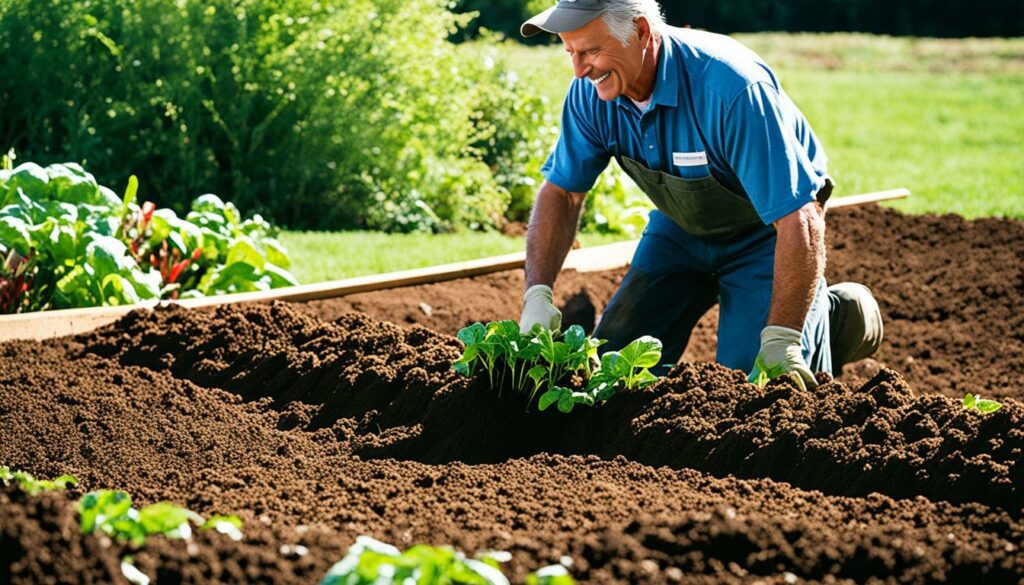
Cover crops bring many good things to the soil. They stop erosion, keep nutrients moving, and stop the soil from getting too hard. Studies in places like Wisconsin and California show how great they are for the soil and what grows in it.
Traditional farming without cover crops can make the soil weaker. But by adding cover crops, the soil gets better and the tiny living things in it grow more. Project by SARE has been helping since 1988 to make the soil healthier with cover crops.
| Benefits of Cover Crops | Impact on Soil Fertility |
|---|---|
| Reduce Soil Erosion | Maintains soil structure |
| Improve Nutrient Cycling | Enhances availability of nutrients |
| Increase Soil Organic Matter | Boosts microbial activity |
| Decrease Nutrient Leaching | Preserves soil nutrients |
| Create Habitat for Pollinators | Supports biodiversity |
With cover crops and compost, soil stays fertile. This is good for the environment and helps crops grow well for a long time.
To plan your spring planting, focus on the soil temperature, frost dates, and what crops you want to grow. This helps your plants grow strong and gives you lots of fruits and vegetables.
From late February to early March, start growing certain plants indoors. These include cabbages, kale, and other greens. Starting early gives them a warm place to grow before the outside weather is fit for them.
By the time March is ending, you need to plant peas and other spring greens directly in the soil outside. You should also start growing peppers and tomatoes indoors. This makes sure they are ready to face the cold of March and push through.
When April is starting, focus on sowing radish, beets, and carrots straight into the ground outside. Plants like okra and basil are better started indoors during this month. It’s also the right time to move those indoor greens into your garden.
Later in April, sow more radish, beets, and carrots outside, along with planting the first seeds of summer vegetables indoors. Keeping the agricultural routine during spring will really help in your garden’s success.
From May to June, the frosty risk is mostly gone, so it’s safe to plant beans and other summer crops outside. This is also the best time to move tomatoes and other garden plants outdoors. It will help them make the most of the warm season.
It is key to prepare the soil well before planting. Clear off mulch from the soil a week or so before. Make sure to dig big enough planting holes and put enough mulch around the plants without touching the stem to avoid sickness. By doing these steps, your plants have a better chance at growing strong.
| Activity | Time Period | Actions |
|---|---|---|
| Start Indoor Planting | Late February to Early March | Cabbages, kale, broccoli, cauliflower, onions, leeks, endive, escarole, fennel, lettuce, artichokes |
| Direct-Sow Outdoors | Mid- to Late March | Peas, spinach, fava beans, arugula |
| Start Indoor Planting | Mid- to Late March | Peppers, tomatoes, eggplant, Swiss chard, tomatillos |
| Second Succession Direct-Sow Outdoors | Early to Mid-April | Radish, beets, carrots |
| Transplant Outdoors | Early to Mid-April | Cabbages, kale, broccoli, cauliflower, onions, leeks, endive, escarole, lettuce |
| Direct-Sow Outdoors | Mid- to Late May through June | Beans, corn, squash, melons, summer carrots |
| Transplant Outdoors | Mid- to Late May through June | Tomatoes, peppers, eggplant, Swiss chard, tomatillos, cucumber, zucchini, okra, basil |
Managing crops well is key for great productivity and quality. It’s vital to choose the right seeds and use herbicides and pesticides correctly. In this guide, we go deep into tips that will help you manage your crops well.
It’s crucial to pick the right seeds to get the best out of your soil. Look at soil tests and local weather to choose seeds that fit. Also, make sure to plant your seeds at the right depth, which is usually between 1.5 and 2 inches. This helps the seeds get enough moisture to grow well.
Using pesticides effectively is a big part of crop care. Follow Integrated Pest Management (IPM) techniques to use less chemical pesticides. IPM uses mechanical, biological, and chemical ways to control pests.
When you apply herbicides, plan it well to protect your crops. Make sure they won’t hurt your plants and that they help you get a good harvest. Test your soil’s nutrients before using fertilisers. This helps you know how much and what type of fertiliser your crops need based on the soil and weather.
Following these farming tips can boost your farm’s productivity and profits. Using a mix of crops helps reduce the risk of failing crops and pests. It also makes your soil better and increases your harvests. Good crop management is key to lasting farming success.
Handling livestock well in spring is key. We need to care for their housing, health, and food. This time is a big change for them. Planning carefully ensures they’re healthy and well looked after.

With warmer spring days, housing must be ready. Good air flow stops sickness. Strong shelters keep animals safe from the weather. Cleaning regularly also prevents diseases.
Spring is perfect for health checks and shots. Watching their health stops diseases. A set vaccination plan keeps them safe from sickness. Deworming and check-ups are also important for their health.
Livestock need the right food in spring, especially as they start using new pastures. A balanced diet is crucial for their health. It’s important to check for nutrient needs too. Various supplements help their growth and immune system.
By feeding, livestock give back to the fields. For each ton of hay they eat, they return nutrients like nitrogen. Watching the grass height and rotating where they graze is vital. It helps keep the pasture healthy and prevents overeating.
“In general, 80% of the nutrients consumed by livestock are redeposited in fields through nutrient cycling.”
The table below helps set grazing guidelines based on forage height:
| Forage Type | Start Grazing Height (inches) | Stop Grazing Height (inches) |
|---|---|---|
| Ryegrass | 6 | 3 |
| Clover | 8 | 4 |
| Alfalfa | 8 | 4 |
| Orchardgrass | 8 | 4 |
In the summer, it is crucial for farmers to manage drought effectively. They need to use advanced irrigation systems. They should also work on conservation methods. Both are important to keep the farm productive during dry spells.
To manage drought well, farmers should focus on efficient irrigation. Technologies such as microirrigation (NRCS Practice 441) help. These include drip tape and tubing. They deliver water right to plant roots. This process uses water wisely, helps keep it from evaporating, and saves water.
It’s vital to watch the soil temperature. High temperatures, over 86 degrees F, can harm plants. For example, corn may stop growing at 95 degrees F. Maintaining soil health is key during droughts. By doing so, farmers can avoid losing too much water.
During droughts, conserving soil moisture is a must. Mulching (NRCS Practice 484) reduces soil temperature. This cuts water loss through evaporation. Cover crops (NRCS Practice 340) are also crucial. They increase the soil’s ability to retain water. Just 1% of organic matter in the soil can hold tons of water per acre.
Managing pastures well is another way to be drought-resistant. By letting forage rest, plants grow taller. This decreases soil evaporation and ensures better water use. In places with variable rainfall, like the northeast of the US, finding this balance is key to farm health.
| Practice | Description | Benefits |
|---|---|---|
| Microirrigation | Delivers water closer to the root zones | Improves water efficiency and reduces evaporation |
| Mulching | Lowers soil temperature and conserves moisture | Reduces water loss through evaporation |
| Cover Crops | Increases organic matter in the soil | Enhances soil moisture retention |
| Well-managed Pastures | Allows forage rest and recovery | Reduces evaporation and improves water access |
Effective irrigation and conservation are crucial in drought management. Farmers need to improve their methods constantly. This way, they can overcome water scarcity and keep their farms strong in tough times.
In summer, farmers need to stay alert. The heat and too much moisture can cause a lot of problems. It’s important to check your crops often. Look for signs of heat stress or pests. This way, you can act fast to solve any issues. Deciding what to do, with help from experts like Vern Grubinger, can make your crops better and save you money.
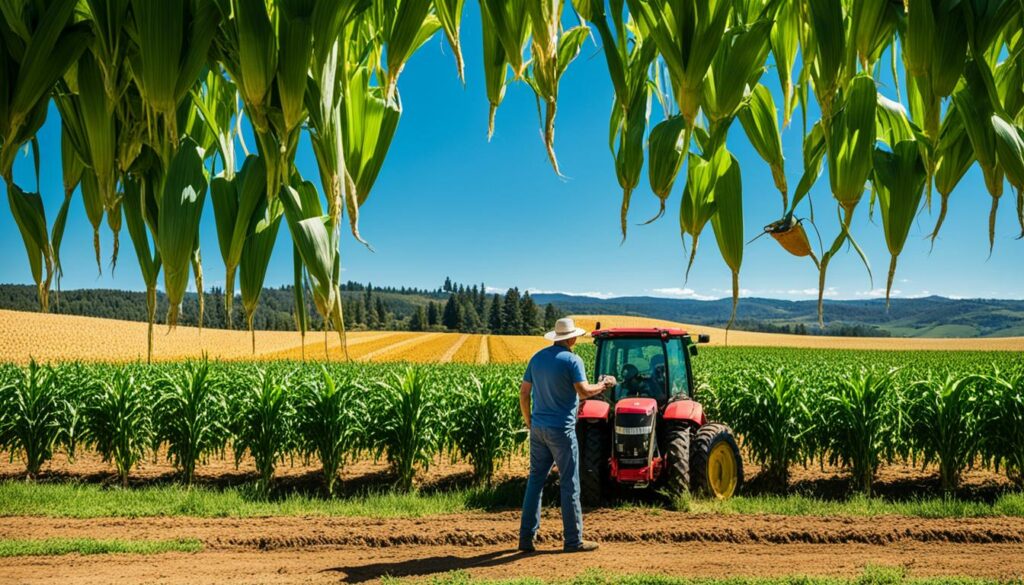
It’s key to water plants at the right times. Using drip irrigation fits with eco-friendly farming. It saves water and helps plants grow better. Make sure you water when your plants need it most. This saves on water and can boost your crop production. It’s especially important in extreme heat. By managing water well, you keep the soil healthy and stop water waste.
Summers can be tough to predict. But, you can beat the heat by watching the weather and shading your crops. This careful work is crucial. It keeps your farms productive and helps during the busy summer.
“Farmers should provide sheep with no more than ten sheep per acre of pasture,” a guideline with broader implications, reflects the precision needed in modern farming practices.
Good tips and advice can help farmers face the tough summer. They can protect and make their crops thrive even in the hottest months.
As temperatures climb, keeping livestock cool is top priority. High heat can hurt animals and their work. It’s key to have cooling and good shelter for them.
Heat makes shade essential. Use portable shelters to protect animals from sun. This helps all animals but is extra vital for the very young or old. By moving these shelters, you keep animals happy and healthy.
For more information, check out animal welfare tips.
For farms, fans are life savers. They cool the air and help fight off heat stress. Don’t forget about water. Animals must be able to drink lots. Make sure cooling matches what each animal needs.
Back off on moving animals when it’s hottest and keep their water cool. Watch out for these heat stress signs: heavy panting, not moving much, lots of drinking, or refusing food. If you spot any, provide shade right away. If things don’t get better, get help from a vet. Personalised care keeps livestock well and working.
Understanding seasonal crop care, agronomy tips, and agricultural best practices is key for farm success. Each season brings new challenges and chances. Farmers need to use specific strategies for the best results.
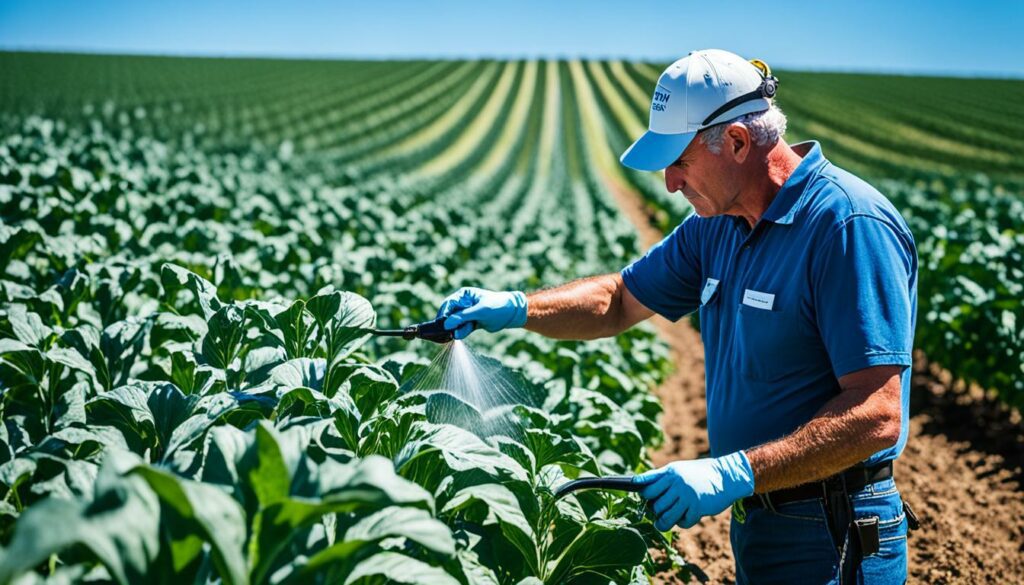
The spring begins on March 20th and is a busy time for farmers. They should check the soil to test for things like phosphorus and pH as advised by Ohio State University Extension Service. This is also the season for new animal births, which means a growth in livestock. Having a plan for drought and conserving water is important.
It’s best to plant crops and apply herbicides from late March to late June. This is when the warm season crops have the best chance to grow.
Summer extends from July to early September and is critical for heat management. Farmers must watch their corn and soybean fields closely, applying the right amounts of fertilizers and pesticides. Crop scout interns help check on the fields and report back. The weather, including rain and sunlight, affects the crops a lot.
The start of fall (late September to early December) is about harvest. It’s crucial the crops are dry for storage to avoid spoilage. Preparing the soil for planting ahead with practices like fall tillage is important. Work like grain drying has to be done carefully to prevent accidents.
Winter covers December to February. This time is perfect for fixing and maintaining farm equipment. It’s also a good time to buy things needed for the next planting season.
Don’t forget about financial planning. Resources like AgAmerica Lending’s 10-year line of credit can help farmers with funds for year-round operations.
Looking at farming as a whole, with focus on seasonal crop care, agronomy tips, and agricultural best practices, leads to a fruitful and sustainable year on the farm.
As summer ends, farmers start getting ready for the fall harvest. Planning well can improve the quality of crops. It also makes the whole farming process more productive. Preparing in advance and planning carefully is key to a successful harvest time.
It’s important that crops are dry before they’re stored. Farmers watch their crops and adjust when to harvest them. For example, crops like soybeans and corn need to have the perfect moisture content when they’re harvested in September. This stops them from going bad.
When crops are stored correctly, they stay fresh longer. This stops farmers from losing money. It also keeps their crop stores in good condition.
Tillage in autumn is also essential. This means preparing the soil for planting again. It makes the soil healthier and fields ready for planting. A good plan might involve testing the soil to see what nutrients it needs.
Tilling the soil in autumn can also help reduce weeds. It improves the soil and helps crops grow better next year.
After the harvest, caring for the soil is key for its health and future planting. Adding organic material and using strategies to prevent erosion are vital. These methods help keep the soil fertile and strong.
Adding organic material to the soil after harvesting is important. Take Halton Farms in Cheshire, for example. They get an average of 68 tonne/ha with Bellami CS maize thanks to good soil care. Using compost and crops like Nutrino Pro boosts nutrients and meets maize’s flowering nitrogen needs. Planting cover crops after harvest not only adds organic matter. It also makes the soil healthier.
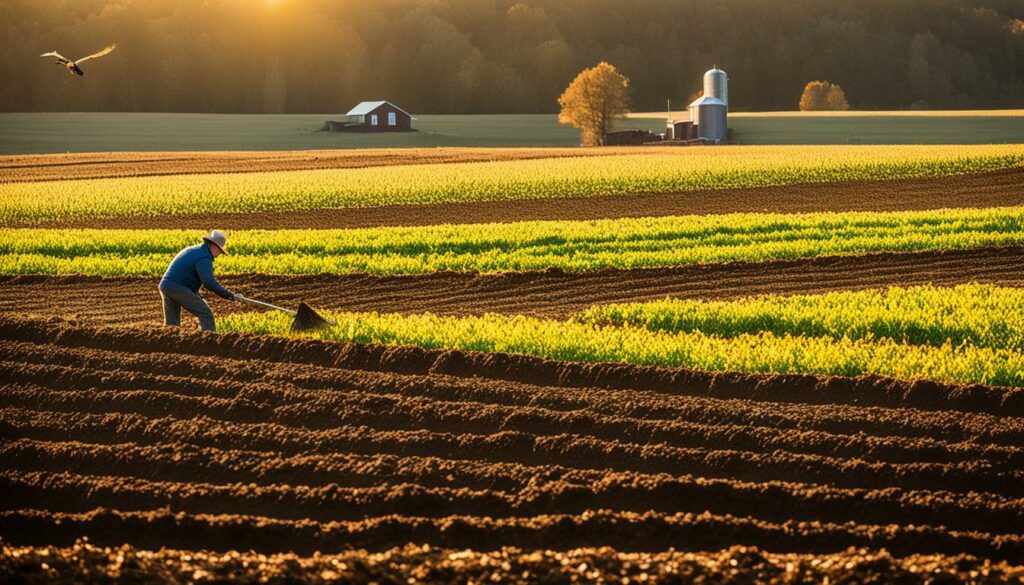
When to plant cover crops matters a lot for good results. Consider crops like oil radish, winter turnip rape, mustard, and more. Working with water companies on these steps can cut erosion risks. This makes farming more sustainable.
Stopping soil erosion after harvest is key to keep the soil’s structure. Changing weather has affected yields and the need for nutrients from the soil. This makes erosion control very important. Planting cover crops on critical lands, especially those on slopes, helps lower erosion. Picking the right cover crops to fit into the overall crop plan also maintains healthy soil.
Being proactive with soil samples on things like soybean cyst nematode (SCN), lime, and nutrients is crucial. Proper care after harvest really boosts farm productivity and soil care.
In winter, agricultural machinery maintenance is key. We must keep our equipment in top shape for the busy seasons ahead. Good care not only makes our machines last longer but also cuts the chances of them breaking down during important times.
Winter’s calm is perfect for fixing our tools. It’s vital to check the coolant to make sure it won’t freeze. We should also look at the battery now and then to catch electrical problems before they become big issues. A tip for diesel engines is to use a winter fuel mix to avoid gelling in the cold. Make sure the heaters and plugs are working too, to avoid trouble starting.
| Component | Maintenance Task | Frequency |
|---|---|---|
| Battery Voltage | Check voltage for safe storage | Monthly |
| Coolant | Test specific gravity for freeze protection | Before winter |
| Diesel Fuels | Switch to winter blends | As temperatures drop |
| Engine Block Heaters | Check and test functionality | Before cold weather |
| Glow Plugs | Inspect and ensure proper operation | Before cold weather |
Looking after our machines in winter is vital. If moisture gets in, it can freeze and rust parts, so use additives in the fuel to pull moisture out. Make sure the oils we use can hold onto any moisture. Keeping fuel tanks full helps against moisture, too. Also, watch the tyre pressure, as it can go down when it’s cold, which might be unsafe.
Before using machinery, clear snow so there’s no ice. This keeps everyone safe. Winter means we need to work extra hard to keep machines in great shape. This involves using the right oils, checking on fluids, and looking at hoses. Doing these things helps keep our equipment ready for the next farming season.
Keeping farms going well in winter is a challenge because of the cold weather. It’s important to pick plants that can handle the cold and stop the soil from washing away. This helps farming continue even when it’s freezing outside.

Choosing the right crops for winter is key. Think about planting things like winter rye, barley, and some types of wheat. These plants are strong enough to survive the cold.
When planting, go about 1.5 to 2 inches deep. This depth helps keep the seeds moist for them to grow well.
Erosion, or the wearing-away of soil, is a big problem for farms. To stop this, farmers can plant over the soil with cover crops. They can also avoid ploughing too much and use natural mulches. These methods help the land stay healthy.
Before adding any fertilisers, it’s crucial to test the soil. This way, you can feed the plants just what they need to fight the cold.
Looking after the soil in winter is not just good for the land. It also makes sure farms can keep running and producing food when it’s cold outside.
| Method | Benefits |
|---|---|
| Using Cover Crops | Prevents erosion and replenishes nutrients |
| Reduced/No-Tillage Farming | Improves soil health and accumulates soil carbon |
| Organic Mulches | Protects soil and enhances moisture retention |
Good farm financial planning is key to a successful operation. It helps farmers keep their business strong and ready for what’s ahead. Let’s look at some important tasks to focus on.
Filing taxes correctly and on time is vital. Farms have special tax rules, like deductions for tools and eco-friendly practices. Keeping your financial records up to date makes tax season easier. It helps you see where you’re spending money and where you can save.
An organised farm benefits a lot from saving on costs. Whether it’s working less or wasting less, managing your finances digitally helps a great deal. It shows you sales and costs trends, which you can use to make more money.
It’s smart to check on your supplier deals every so often. Looking at what you’re paying for essentials like seeds and fertilisers can save you money. By changing when you buy, you could get these items cheaper during certain times of the year.
Using wind or solar power at your farm can cut your energy bills. This saves money in the long run. Plus, planting cover crops can keep the soil healthy and your costs down by reducing the need for weed killers.
Making your own fertiliser from farm waste can be a cheaper, eco-friendly option. And when choosing pesticides, looking at your choices and not just the brand can save you cash while still keeping pests away.
To sum up, paying close attention to agricultural administration details is important. Things like keeping good records, reviewing contracts, and using tech well can make a big difference in how your farm does financially. When you’re on top of these areas, your farm is set for success and staying strong economically.
Looking back at the agricultural tips shared in this article, it’s clear we’ve come a long way since World War II. Today, fewer farmers can produce more food and fibre cheaper than ever before. This shows how important it is to keep learning and using the best farming advice.
To keep farms productive all year, using the right crop rotation and sequencing is key. It’s best to not grow too much of one crop type on your land. This keeps things varied and balanced. Using short sequences with two or three different crops makes it easier for farmers. Small Valley Farm is a great example. They use a six-year plan on their 720 acres, which works well for them.
Another important thing is to know your fields well and watch for any problems. By checking for wet spots or warm areas early on, farmers can plant their crops more effectively. Also, in the last forty years, there’s been a big push for farming that’s good for the environment, makes money, and is fair to everyone. Combining these ideas helps farmers build systems that are strong, flexible, and full of variety.
As we wrap up, we see that thinking ahead and using the right farming methods all year is crucial for success. It’s about constantly learning and dealing with new challenges. By doing this, farmers can make sure their farms are profitable and sustainable. Farming has its ups and downs, but with the right knowledge, we can face it confidently. This way, we can look forward to great harvests and a bright future.
Checking farm tools and buildings in spring is key. It helps farmers find and fix issues early. This ensures everything works well when farming gets busy.
Soil tests show soil health, helping pick the best plants. This means better conditions for crops, leading to higher yields.
Start early if warmer weather is coming. It lets plants grow better through the season, giving a bigger harvest.
Good composting makes soil rich for plants. It’s great for growing strong and healthy crops. This improves farming for the long term.
Cover crops help the soil stay healthy and prevent it from washing away. They’re good for farming, making it both successful and eco-friendly.
Think about soil warmth, frost dates, and what plants like your area. Choosing wisely helps your plants grow well.
Use soil and climate info to pick seeds. This makes sure you grow strong, healthy crops that do well where you farm.
Start with a little herbicide and pesticide to protect your crops at the right time. It keeps them healthy and increases your harvest.
Before spring, make sure animal shelters are ready. Check their health and give vaccinations to keep them well as the season changes.
Feed your animals right, especially the young ones. This keeps the whole herd healthy and ready for fresh pastures.
Use water wisely with smart irrigation. Save moisture in the soil with good farming practices. This helps your plants and animals stay healthy.
Keep an eye on crops in hot weather, water them well, and solve any problems fast. This keeps your plants strong in the summer heat.
Use shade and fans to keep animals cool. These reduce heat stress and keep them healthy and productive.
Make sure crops are dry enough for storage. Tilling the land after harvest keeps soil healthy for the next planting time.
Add organic matter and prevent soil erosion to keep it fertile. This is good for the soil and your future crops.
Winter is a good time to fix and store machinery well. This prevents damage and keeps everything ready for the next farming season.
Pick crops that don’t mind the cold. This way, you can farm even when it’s chilly and keep producing through the winter.
Handling farm paperwork and money matters keeps everything running smoothly. It’s vital for a successful and sustainable farm business.